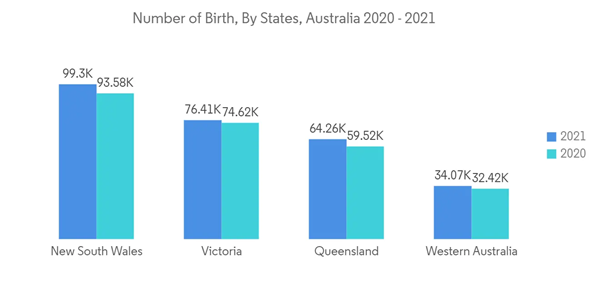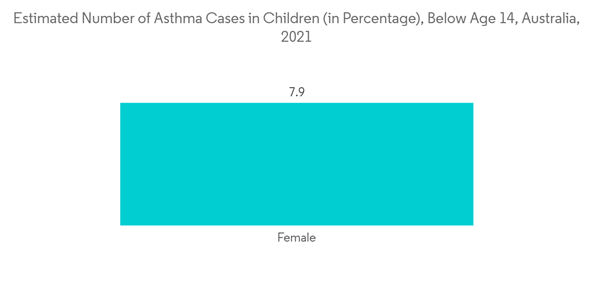Despite having a strong health system that includes national strategies and models for outbreak control, Australia's healthcare system suffered during COVID-19. Most of the healthcare workforce was directed to emergency rooms to help individuals infected with the virus. This had a significant influence on elective operations and had an adverse impact on the growth of the studied market within Australia. Moreover, initiatives by the key market players are also expected to increase the market growth as both neonatal and prenatal devices are expected to regain their pre-pandemic demand over the forecast period of the study.
The significant factors for the market growth include the rising incidence of preterm births and increasing awareness of prenatal and neonatal care. Initiatives by public and private organizations are expected to increase the market growth. In April 2021, the Australian government invested around USD 12 million to support and expand the Heart of Australia program, including delivering mobile medical clinic services across northern Queensland. The mobile medical clinic provides access to cardiology, cardiac monitoring, and other services. Such support from the government in providing cardiovascular services will raise demand for neonatal monitoring devices and drive market growth.
Similarly, in June 2021, Healthcare technology supplier Hospital Products Australia (HPA) distributed Mindray's innovative medical devices and solutions in the Australian market following the announcement of a partnership between the two companies. Thus, owing to the above-mentioned factor,s it is expected to drive market growth during the forecast period. However, the low birth rate in the country is expected to hinder the market's growth.
Australia Neonatal & Prenatal Devices Market Trends
Incubators Sub-segment Expected to Hold a Significant Market Share
Neonatal incubators are often necessary for infants. The infants need respiratory support, ranging from extra oxygen to continuous positive airway pressure (CPAP) or mechanical ventilation. The temperature regulation of infants is among the major factors to be controlled in neonatal incubator cases. The companies have varied devices on several parameters, among which temperature regulation is essential, as severe temperature differences lead to neonate heat loss, hypothermia, and apnoea, which are closely related to airflow and air velocity. The increasing birth rate is expected to increase the demand for incubators to support newborn babies if required. A press release published by the Australian Bureau of Statistics in October 2021 stated that in 2021, 309,996 births were officially recorded, up 15,627 (5.3%) from the previous year. The overall fertility rate for all Australian women was 1.70 births per woman. The general fertility rate for Aboriginal and Torres Strait Islander women was 2.34 births per woman. The gender ratio at birth was 105.2 male births for every 100 female births because 51.3% of the population was male.Initiatives by key market players are another factor in market growth. In March 2022, the MINC+ Benchtop Incubator was launched by Cook Medical for clinical embryologists and IVF clinics in Australia. Such product launches are expected to increase prenatal care in the country, which is expected to augment market growth during the forecast period. Similarly, in June 2021, an incredible 12.2% increase in the number of live births for those who are having trouble getting pregnant has been achieved thanks to research by Australian scientists who developed a novel incubator and an improved version of the fluid in which embryos develop. The Geri incubator, available to Genea patients, photographs an embryo every five minutes at up to 11 cross-sections. It then compiles the images to display detailed time-lapse footage on a screen, enabling scientists to examine embryos without subjecting them to harmful conditions, such as temperature changes. Thus, such initiatives are expected to increase market growth during the forecast period.
Respiratory Assistance & Monitoring Devices Sub-segment to Show Significant Market Growth
Respiratory assistance and monitoring Devices are used to monitor and treat patients suffering from respiratory disorders such as asthma, COVID-19, etc. Factors such as the increasing prevalence of respiratory diseases are expected to increase market growth. In September 2022, a research study published in the National Library of Medicine stated that the prevalence of protracted bacterial bronchitis (PBB), chronic suppurative lung disease (CSLD), and bronchiectasis is high in aboriginal children, and regular wet cough increases with age in Australia.The availability of action plans provided by the government is another factor in market growth. The action plans would provide knowledge about using devices to monitor and treat diseases. In July 2022, the Australian Institute of Health and Welfare estimated 35% of people with self-reported asthma across all ages had a written asthma action plan. Two-thirds (66%) of children under 18 had a written action plan. Thus, such high availability of action plans for children is expected to increase market growth during the forecast period. Thus, the increasing prevalence of respiratory disorders and the availability of action plans are expected to increase segmental growth over the forecast period.
Australia Neonatal & Prenatal Devices Market Competitor Analysis
The Australian neonatal and prenatal devices market is consolidated and competitive. Some of the market players are GE Healthcare, Getinge AB, Koninklijke Philips NV, Masimo, Medtronic PLC, Natus Medical Incorporated, and Vyaire Medical, among others.Additional benefits of purchasing the report:
- The market estimate (ME) sheet in Excel format
- 3 months of analyst support
This product will be delivered within 2 business days.
Table of Contents
Companies Mentioned (Partial List)
A selection of companies mentioned in this report includes, but is not limited to:
- GE Healthcare
- Getinge AB
- Koninklijke Philips NV
- Natus Medical Incorporated
- Vyaire Medical
- Medtronic PLC
- Masimo










